Christmas cacti are not too easy to care for, but if you can, they will go a long way. Sometimes the care routines or cultural conditions are not in alignment with the plant’s needs which can lead to several issues such as yellowing leaves.
And in this article, we shall learn why is your Christmas cactus turning yellow and how you can fix the same?
Low light, inadequate fertilization, and overwatering are prime reasons the Christmas cactus turns yellow. Other reasons could be pests, transplant shock, and fungal diseases, which can lead to yellow leaves. Identify the cause and take the necessary steps to fix the yellow leaves problem.
We need to know the real cause and the right process to treat the problem.
By reading the article, you will identify the cause of yellow leaves in the Christmas cactus and treat the same with ease.
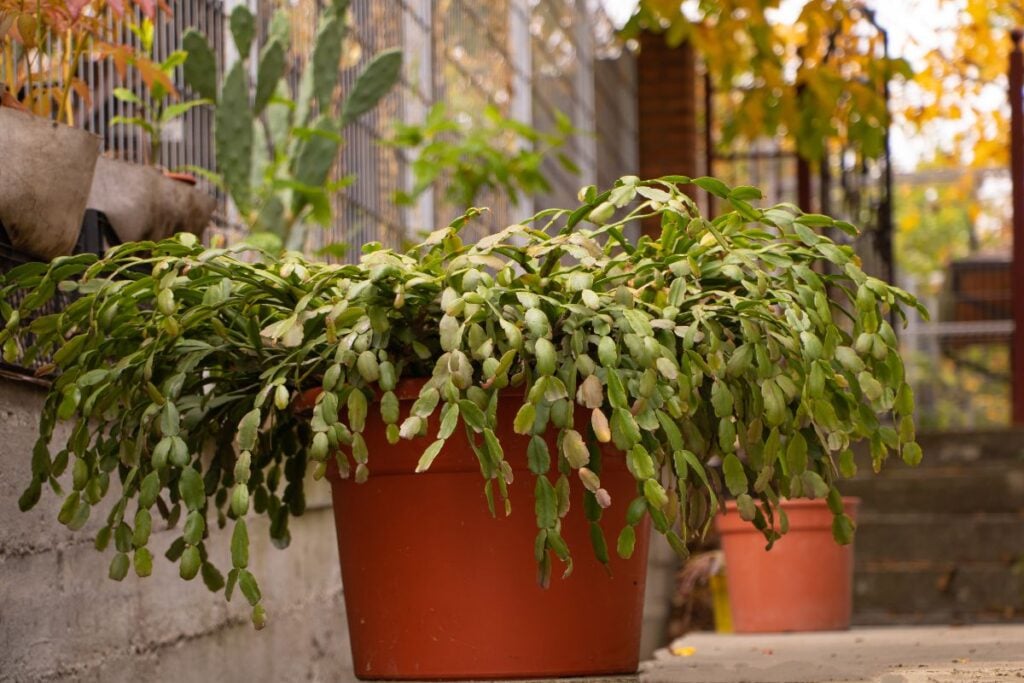
What causes yellow leaves on Christmas cactus?
Christmas cactus with green segmented stems may turn yellow for several reasons, which you should know before treating.
They are unhappy due to the following causes:
- Watering issues
- Fungal Diseases
- Lighting problems
- Temperature stress
- Repotting
- Pests
- Inadequate fertilizer
Let’s discuss these causes in detail below:
Watering issues
Watering the Christmas plant is a tricky part. It is the root cause of most of the problems in the plant.
It could be under watering or over watering, and both can lead to yellowing of the plant.
The first step is to determine whether it is under-watering or over-watering.
Under watering
During dry conditions, i.e., when the plant lacks water for a long time, you will notice dry and falling stem segments.
It happens when you are either out for some time or skipping your watering schedule consistently.
Another possible reason could be extremely draining soil that cannot hold moisture at all.
The soil releases almost all the water it receives through the drainage holes.
Due to this, the roots also have less or no water available; the roots are bone dry and cannot supply water to other parts of the plant, which turns the stems yellow.
You will see the following signs when the plant is under-watered:
- Shriveled leaves
- Droopy leaves
- Stems turning yellow
- Weak and dry plant
- New stems turning yellow
- Crispy yellow tips
It would be best to examine the stems to understand the signs properly and closely.
That is possible only if you take some extra time with your plant every few days.
Also read: How Often To Water Christmas Cactus? (Water Requirement+Tips)
Over watering
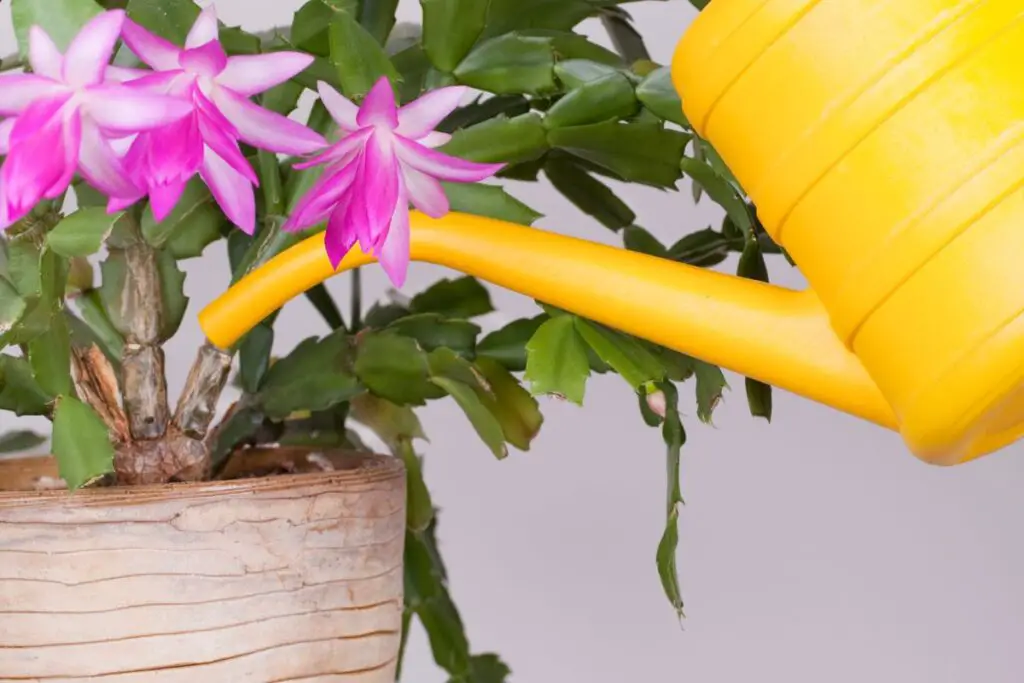
The stem segments turn yellow and wilt if the Christmas cactus is overwatered. The root and soil are waterlogged due to excess water. You might not be giving them time to dry before watering.
Inadequate drainage holes can also lead to waterlogging, which can lead to overwatering.
The soil is said to be wet within, and the overwatered conditions occur with regular watering. The roots and soil cannot breathe and supply water and nutrients to the entire plant.
That leads to soggy and yellow stems.
Another cause could be heavy soil mix, which means the soil holds moisture for a very long time, leading to over-watered conditions.
The pathogens sitting in the soil get their food and start developing. The entire plant lacks nutrients and water.
Also read: Root Rot In Christmas Cactus? (Signs, Causes & Fix)
Fungal diseases
Christmas cactus is susceptible to fungal diseases. The effects of these diseases are often mistaken for bugs.
There could be different reasons for different diseases.
The prime reasons for any disease on Christmas cactus are drowning soil, poor drainage, cool weather, etc.
See the table below to know the possible reasons for all fungal diseases.
| Fungal leaf spots | Over watering Keeping in shaded areas poor ventilation root rot water droplets sitting on stems |
| Bacterial leaf spots | Poor ventilation Pathogens development Mycelium formation grouped plant |
| Powdery mildew | Poor light Poor air circulation excess misting Water-logged soil |
| Anthracnose | Fungi in the genus Infected plant or surrounding plant. |
Lighting Problems
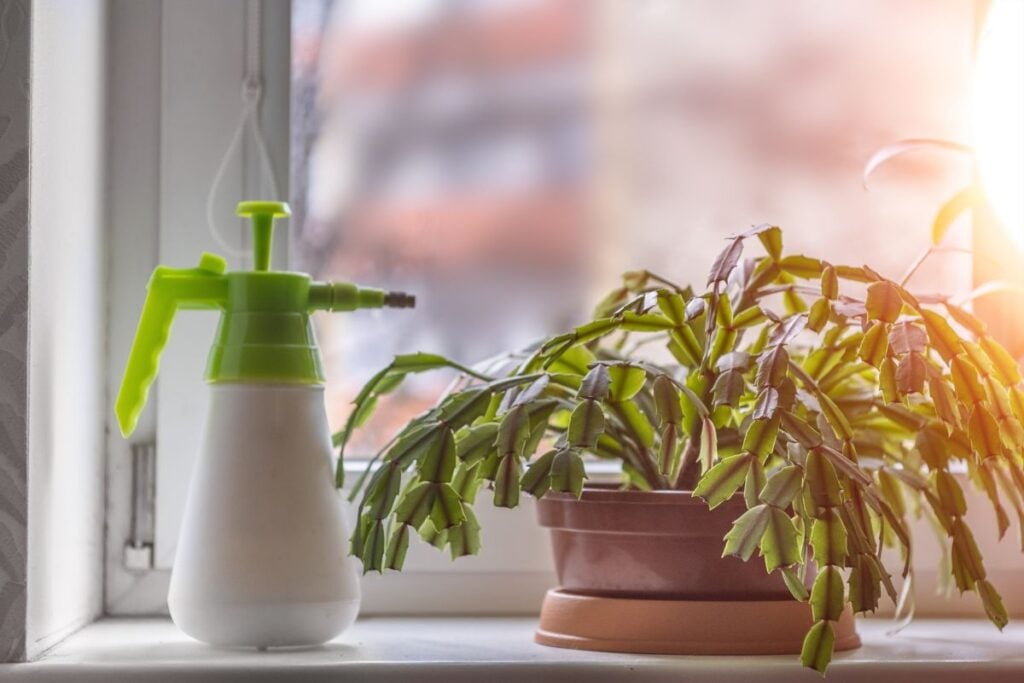
Christmas cactus in their native environment gets dappled light through the big trees. In households, when kept on a windowsill or balcony, they may receive direct light.
They appreciate good light, but some planters expose them to extreme light leading to pale and yellow stems.
They keep them near windows so the plant can get a lot of light but also includes intense sun hours of the day.
Keeping Christmas cactus near window glass, especially during winters, is a big mistake because the sun reflecting through the window is even more intense for the plant.
Too much light dehydrates the plant, which also leads to yellowing.
On the other side, too little light is also not recommended. Lack of light or keeping them in the dark room will become the reason for the yellowing of the plant.
The light is required to produce chlorophyll required for photosynthesis.
Because of insufficient light, the plant will lose its green color, turning pale and yellow.
Don’t deprive your Christmas cactus of light; they need it to carry out all the important functions and stay green.
Also read: How Much Light Does My Christmas Cactus Need?
Looking for gardening supplies? We have tested 100's of products before recommending them to you guys. Check out our best pick below:
| Image | Gardening Supplies | Best Price? |
|---|---|---|
 Top
Top Top
Top | Raised Garden Bed Kit | Check On Amazon |
 | XLUX Soil Moisture Meter, Plant Water Monitor, Soil Hygrometer Sensor for Gardening, Farming, Indoor and Outdoor Plants, No Batteries Required | No Results |
 Top
Top Top
Top | 82 Pcs Garden Tools Set and Extra Succulent Tools Set | Check On Amazon |
 | Joeys Garden Expandable Garden Hose with 8 Function Hose Nozzle, Lightweight Anti-Kink Flexible Garden Hoses, Extra Strength Fabric with Double Latex Core, (50 FT, Black) | No Results |
 Top
Top Top
Top | Dual Chamber Compost Tumbler | Check On Amazon |
 Top
Top Top
Top | Sunnyglade Plant Stakes | Check On Amazon |
 Top
Top Top
Top | Organic Cold Pressed Neem Seed Oil | Check On Amazon |
 Top
Top Top
Top | Mighty Mint Gallon :-Insect and Pest Control Peppermint Oil | Check On Amazon |
 Top
Top Top
Top | Scotts DiseaseEx Lawn Fungicide | Check On Amazon |
 Top
Top Top
Top | Jacks Classic 20-20-20 All Purpose Fertilizer | Check On Amazon |
 Top
Top Top
Top | 30,000 Seeds Pollinator Attracting Wildflower Mixture | Check On Amazon |
 Top
Top Top
Top | Survival Vegetable Seeds Garden Kit-Over 16,000 Seeds | Check On Amazon |
Temperature
Temperature shock is one of the causes of yellow leaves. It is the initial signal that your plant is not well.
Christmas cactus show stress through stems when there is a frequent shift in temperature levels.
Due to cold drafts in winter, these plants suffer as their functioning gets disturbed.
It also affects the production of chlorophyll which we see as yellow leaves. Temperature leads the plant to suffer the most when fluctuating frequently.
It can be due to a change in its location too. The temperature level inside and outside is different, and if you move your plant frequently, then the possible reason is frequent movement.
Even hot drafts during summers also affect the plant’s health. It directly affects the plant leaves, resulting in yellow and dry leaves.
Repotting
Repotting is an important part of a plant’s growth. Christmas cactus also needs repotting occasionally, but it can be a disaster for their health when done incorrectly.
It can damage the roots permanently or stress them to a large extent, leading to yellow leaves.
The leaves can stay healthy and green only if the roots and soil are healthy.
If the roots and soil are stressed, the leaves also show signs of stress.
Yellow leaves and curling leaves are a few initial signs of stress.
Repotting is stressful, especially when done untimely or frequently.
The roots cannot support their leaves due to stress, so the leaves turn yellow.
It affects growth and health when you repot your Christmas cactus during the dormant period.
Many planters repot their plant in the scorching sun; this further stresses the plant and leads to yellowing and curling of leaves.
Expecting growth by repotting every few years is useless and pressurizing for the plant. It will only deter their health and development.
Pests
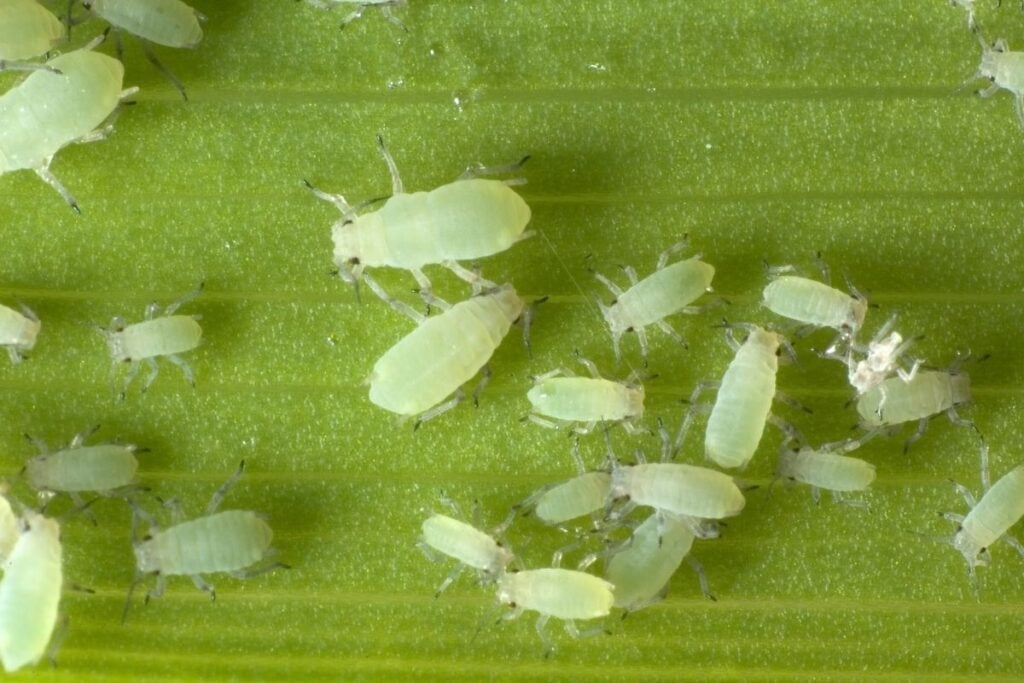
If you are providing appropriate care but still find your Christmas cactus with yellow leaves, then the reason could be hiding in the nooks, leaf joints, under the stems, or in the roots.
They are pests, gradually damaging the leaves, roots, etc.
The leaves turn yellow, indicating that they have been affected due to pests sucking them.
Usually, mealy bugs, spider mites, scales, and fungus gnats infest Christmas cactus. They suck sap from the plant and mature slowly.
They usually attack the plants when kept out for summer, or when the plant is constantly moist, or come as a guest with newly bought plants.
The plant will gradually lose nutrients and become weak. Yellow leaves are initial signs that your plant is stressed and need help.
Also read: How To Get Rid Of Bugs In Christmas Cactus? (Common Bugs+Fix)
Inadequate fertilizer
Fertilizer is an essential part of plant growth.
Christmas cactus lovers need to fertilize them if they want to keep their Christmas gift for years, but doing it in the wrong way can prove to be a disaster for the plant.
If you fertilize the Christmas cactus frequently, the roots and soil absorb nutrients rapidly in the beginning.
Over time the roots will damage and will not be able to absorb nutrients.
Feeding Christmas cacti every month without diluting it can cause major harm to them. Salt build-ups are clear visual in case of over-fertilization.
It becomes a potential reason for yellow leaves.
Also, ignoring fertilizing Christmas cactus is not recommended.
The soil will release its nutrients over time, and the plant will starve to death due to nutrient scarcity. The leaves also lose nutrients and turn pale, yellow, and dull.
Also read: Do Christmas Cactus Need Fertilizer? (How Often+Best Pick)
What do you do when Christmas cactus leaves turn yellow?
Christmas cacti are ready to restore if you are ready to care for them appropriately.
We have all the points written down to fix your Christmas cactus.
Watering adequately
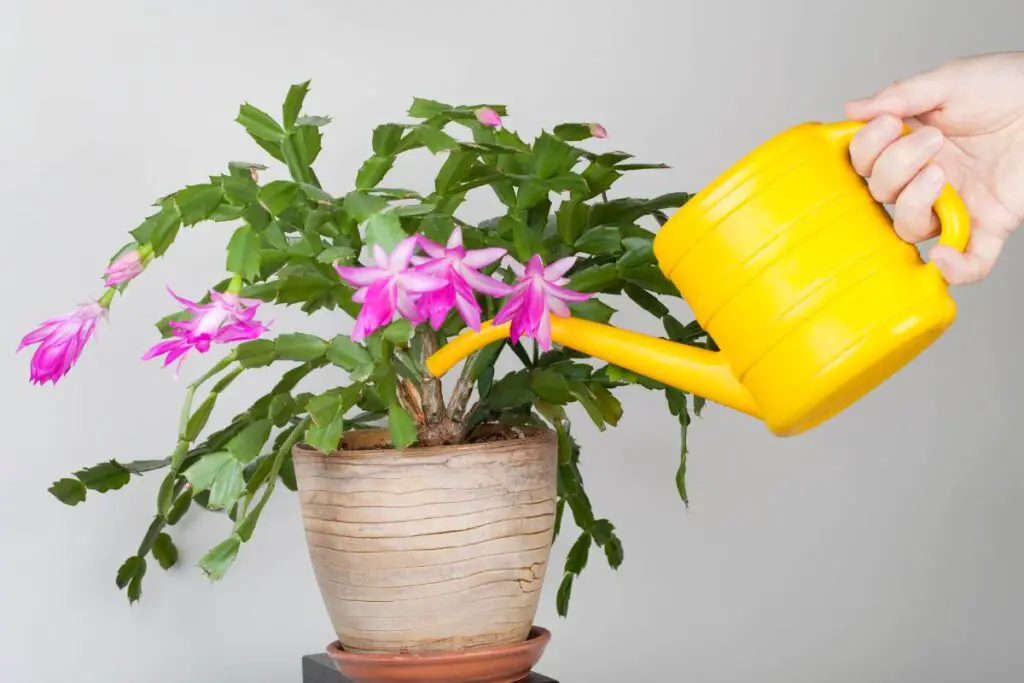
Watering your Christmas cactus sufficiently is the prime point to keep them healthy.
This doesn’t mean you overwater them. Watering adequately means watering when the soil from the top is dry.
Planters often follow a watering regime that can lead to underwatering or overwatering. Always take time to understand your plant’s water needs before following any regime blindly.
With the change in season, the plant’s watering needs also change. It would be best if you watered them mindfully, considering the time they are taking to dry in a particular season.
Check the soil moisture before you shower them, and this rule implies every time you water them.
Check by digging a stick or our finger in the soil from the top up to a few inches. Take it out; if the soil is sticking to it, then the soil is still moist, and you need to hold water for a few days.
Water them with clean water, preferably filtered water, to avoid salt build-ups or fungal diseases. Keep a check on your Christmas cactus to avoid watering problems.
Fungal diseases treatment
The best way to treat fungal diseases is by cutting the infected parts of your Christmas cactus. That will prevent the further spread of the disease too.
Identify the disease and treat it accordingly to save your plant.
We also stress prevention and early treatment to keep your plant in good condition.
In extreme cases, the disease spreads to the entire plant and kills it. In such cases, it is almost impossible to save them.
- Start with removing the damaged parts at the first sign of fungal diseases. There are some effective remedies to treat fungal disease.
- Use ground cinnamon to treat leaf spots. Dip your finger in cinnamon and apply it to the leaf spots gently. You can also sprinkle cinnamon powder on the soil mix in the beginning.
- You can prevent powdery mildew by mixing 3 cups water and 1/3 cup milk. Pour it into a spray bottle, then spray it over the plant. This will cut down powdery mildew in the early stages.
- Make a solution with one-quarter water, 1 tsp baking soda, and ½ liquid soap, pour into a spray bottle, shake and spray all over the plant. Don’t apply during the daytime on hot days; it may burn the leaves.
- Use a copper fungicide to treat fungal diseases once a month. Use it by diluting it to prevent any damage.
- Keep your plant in good air circulation and average humidity to prevent further escalation of the disease.
Fixing Lighting
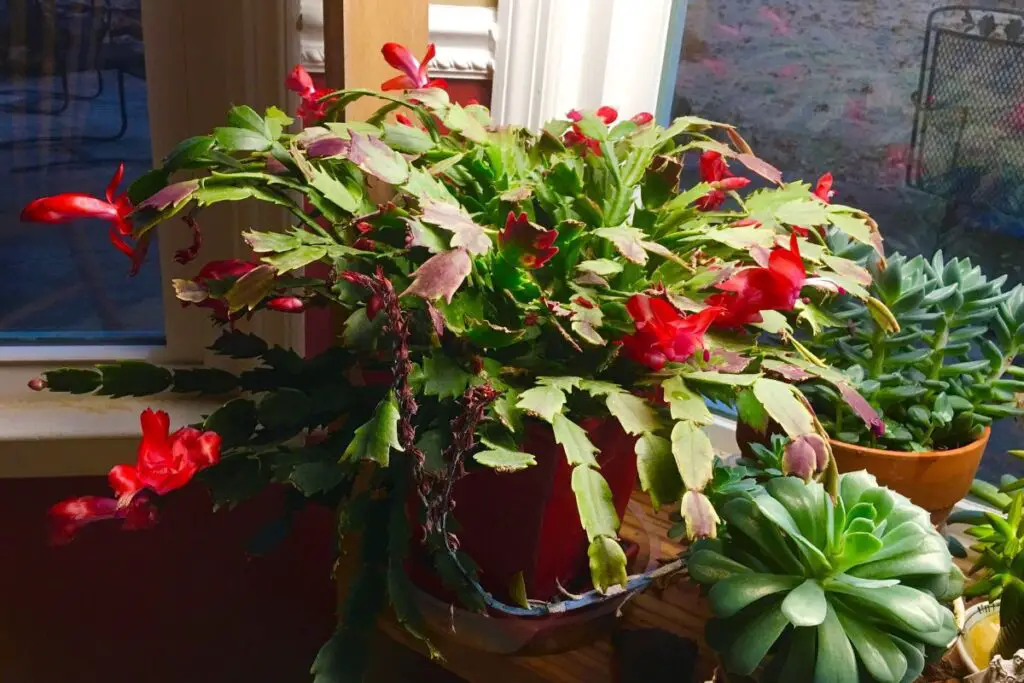
Christmas cacti are light-loving plants but should be protected from direct harsh sunlight.
The leaves may burn in direct sun and turn yellow and brown. You need to identify the right spot by understanding their light needs.
If your Christmas cactus is receiving too much light, move it to a safer distance or use sheer curtains to reduce the light intensity pouring in through the window.
Move your plant gradually from any existing spot to a newer one to reduce the stress as much as possible.
If you move them at once, It can add to the stress and increase yellowing too. Move the plant every 3-4 days to allow them to acclimate to the new conditions.
Keep them near a south-facing or west window but measure the light intensity. If the intensity is harsh for the plant, then use sheer curtains.
If the light received by your Christmas cactus is not enough, then either move to a brighter spot or use an artificial light source.
Artificial light sources such as grow light are feasible to provide your plant with sufficient lighting.
Fixing Temperature
Christmas cacti are different from other cactuses as they need cooler temperatures to bloom.
That doesn’t change the fact that they are cold intolerant. They prefer temperature levels between 60°F to 65°F.
Avoid moving them from one temperature level to another temperature level at once. It can damage the plant and create a lot of stress for them.
Keep them away from heating systems such as vents, radiators, etc.
Also, keeping them away from cold drafts and drafty windows is important, as it can directly affect the plant.
Monitor the space your plant is in, check the temperature level and keep them in a safe space to avoid temperature change. If you need to move them, move gradually to a new space.
Repotting
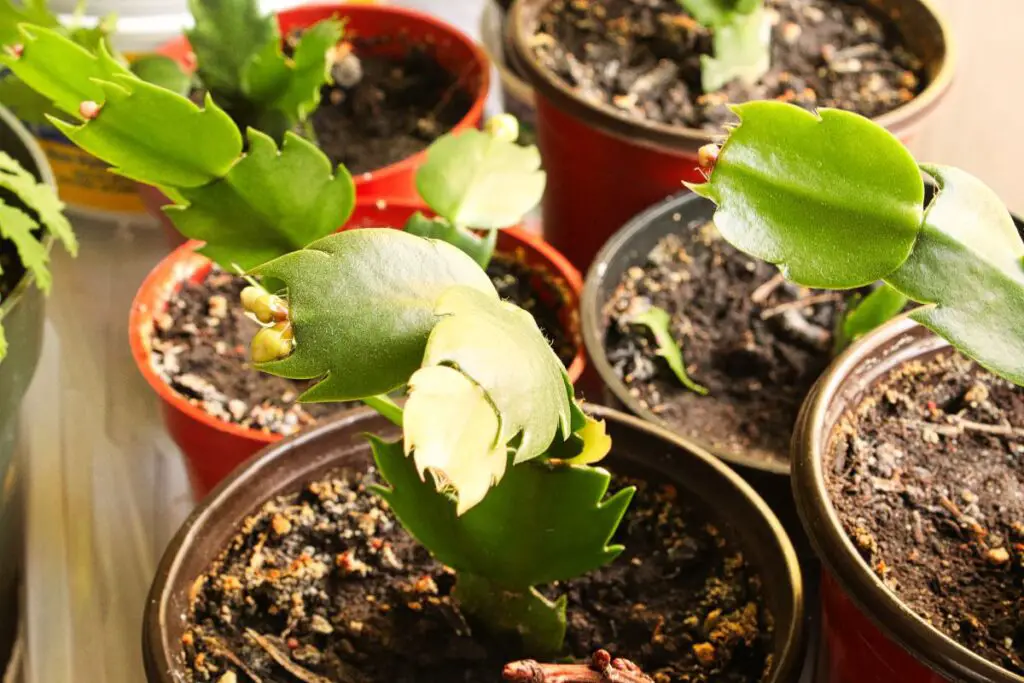
Christmas cactus are slow growers and don’t like to be repotted frequently. If you repot them frequently, you will notice their growth rate has decreased.
Make sure they have a proper drainage system. Clip any damaged leaves or parts of the plant.
Provide enough light and sufficient water to the plant. Water next only when the soil is dry to avoid over watering.
Maintain average humidity level and average temperature. That also helps the plant to reduce and face transplant stress.
Also, avoid moving them to any new space and let them stay in an existing spot after repotting. Also, avoid fertilizing them for at least a month after repotting as it may increase the stress.
The right time to repot Christmas cactus is after flowering ends or early spring. Do not repot them when they are blooming but only after the flowers have wilted.
Treating pests
Treating pests on your plants is crucial as it may kill your healthy plants in no time. Let us discuss the treatments for your pest-infested Christmas cactus:
Neem oil
You can use neem oil to treat pests. Dilute 1-ounce neem oil to 1-gallon water.
Pour it into a spray bottle and spray all over the plant, preferably in the morning. Reapply every week interval if the infestation is severe.
Pyrethrum spray
Pyrethrum spray is a natural bug spray. It attacks the insect’s nervous system and kills them.
Mix it with water and mild dish soap. Follow the label and apply accordingly all over the plant.
Pepper spray
Pepper spray is also very effective in repelling pests by spraying a mixture of pepper and 1-gallon water. Spray on all parts of the plant every week until it’s gone.
Soapy water
Wash the plant thoroughly with soapy water if you want those stubborn pests gone.
Any mild dish soap with half-liter water can be mixed and sprayed on the plant. With consistent application, the bugs will be gone.
Rubbing alcohol spray
Take isopropyl alcohol (2 cups) and water (1/2 cup) and mix in a bottle. Spray this solution on the plant every 2-3 days to repel pests.
Garlic
Garlic has a strong smell which helps to keep pests at bay. Make a paste of garlic and water in a grinder. Let it stay in a container overnight and strain in the morning.
Now, take a jar and pour the paste and add 1 tsp soap, 1-1/2 cup vegetable oil, and water to fill the jar.
Mix 1 cup from the jar with one-quarter of water when you want to use it.
Nicotine
Take dried tobacco leaves about 1 cup and soak them in 1 gallon of water, and add 1 tsp dish wash to it.
After soaking for an hour, strain the mixture and spray on the plant to attack the insects and kill them.
Fertilizing adequately
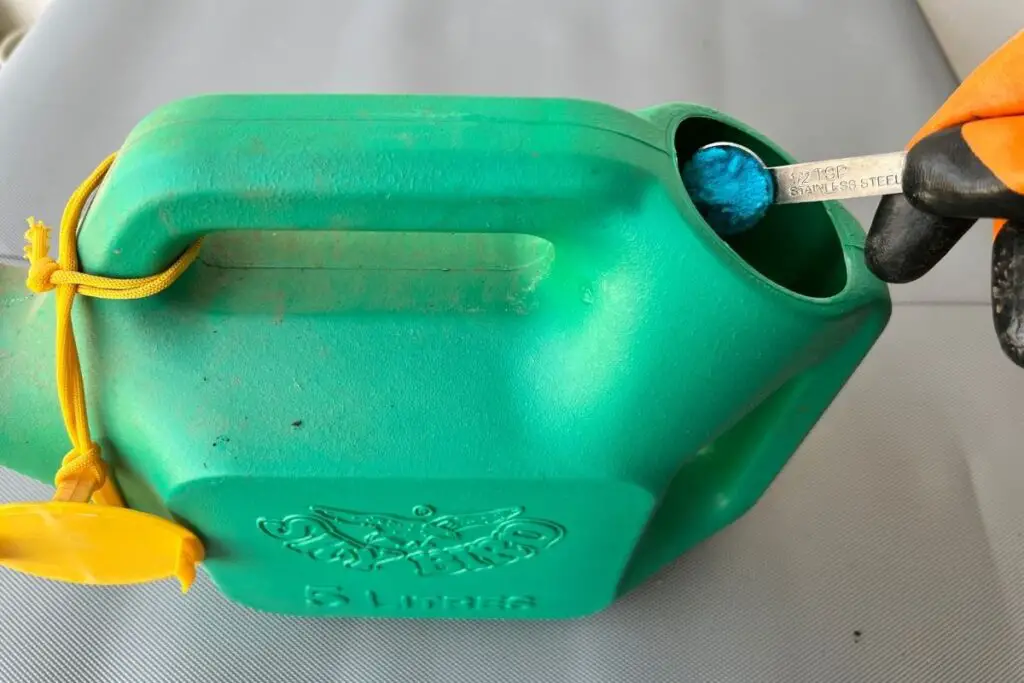
Fertilizing Christmas cactus inadequately can be dangerous for them, especially for the blooming part.
If you have overfed your Christmas cactus, they will react to it. You must stop and check when and how much you need to feed them.
Either you are feeding them frequently or feeding without diluting the fertilizer.
In the case of under fertilization, you might be skipping fertilizing them for a long time.
To fix the issue:
- Start with detecting the damaged parts of the plant.
- Fertilize, if underfed, with balanced fertilizer by diluting to half the strength.
- Skip fertilizing for at least a month or until the condition improves if over-fertilized.
- Do not fertilize during the dormant months.
How do you keep a Christmas cactus healthy?
Christmas cactus are beautiful cacti that are different from other cactuses due to their requirements. If you want to keep them healthy, you need to keep some points in check.
Christmas cactus should be watered only when the top 1-2 inches of the soil is dry. Stay on the under-watering side and avoid over-watering.
Give them ample indirect bright light and avoid direct light. Direct light can harm the leaves directly.
Feed the plant with diluted balanced houseplant food. Fertilize once every two months in the growing season.
Also, water the plant one day before fertilizing them to improve the distribution of nutrients.
Reference: NC State University, Nebraska Extension in Lancaster County, Researchgate, Texas A&M University, Chicago Botanic Garden.
